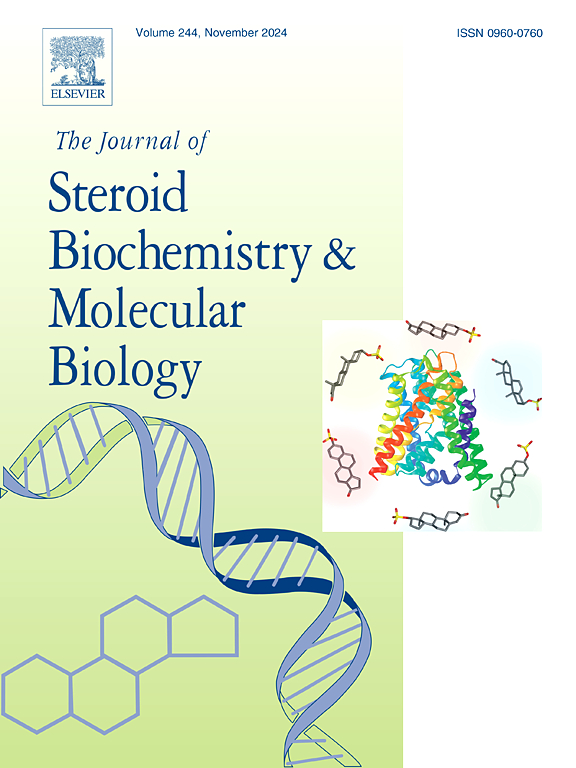Bushen Huoxue formula component β-Estradiol 3-acetate treats osteoarthritis through enhancing the TLR4 ubiquitination
IF 2.5
2区 生物学
Q3 BIOCHEMISTRY & MOLECULAR BIOLOGY
Journal of Steroid Biochemistry and Molecular Biology
Pub Date : 2025-09-12
DOI:10.1016/j.jsbmb.2025.106862
引用次数: 0
Abstract
We aim to explore the key metabolic components and underlying mechanisms of the Bushen Huoxue Formula (BH) in treating Osteoarthritis (OA). The mouse knee OA model was constructed using the destabilization of the medial meniscus method. OA mice were orally administered the BH. Mouse cartilage damage was assessed. High performance liquid chromatography-tandem mass spectrometry (HPLC-MS), network pharmacology analysis and molecular docking were employed to analyze the serum metabolite components and target protein of BH. After lipopolysaccharide (LPS) treatment, different concentrations of β-Estradiol 3-acetate were added to primary chondrocytes. Flow cytometry was utilized for detecting cell apoptosis. The Ubiquitin-Specific Protease 13 (USP13)/Toll-like Receptor 4 (TLR4)/Myeloid Differentiation Primary Response Protein 88 (MYD88)/NF-κB pathway and the TLR4 ubiquitination levels were assessed using immunological quantification and biochemical methods. Relative to normal mice, OA mice exhibited decreased knee joint cartilage thickness and increased inflammatory damage. BH treatment reversed these effects. Furthermore, BH enhanced TLR4 ubiquitination. Estradiol acetate was identified as the metabolic component of BH that alleviates OA. Estradiol acetate and its subtype molecule β-Estradiol 3-acetate could bind to the USP13 protein. The β-Estradiol 3-acetate concentration-dependently decreased the elevated levels of USP13, TLR4, MYD88, p-p65/p65 in chondrocytes induced by LPS, while increasing the TLR4 ubiquitination. β-Estradiol 3-acetate reversed LPS-induced chondrocyte apoptosis and elevation of inflammatory factors. Moreover, USP13 overexpression abolished the protective effects of BH and β-Estradiol 3-acetate against LPS-induced chondrocytes. In Conclusion, the BH metabolite β-Estradiol 3-acetate promotes TLR4 ubiquitination to relieve inflammation and apoptosis in OA chondrocytes by inhibiting USP13.
补肾活血方成分β-雌二醇3-醋酸酯通过增强TLR4泛素化治疗骨关节炎。
我们旨在探讨补肾活血方治疗骨关节炎(OA)的关键代谢成分及其作用机制。采用内侧半月板失稳法建立小鼠膝关节OA模型。OA小鼠口服BH。评估小鼠软骨损伤。采用高效液相色谱-串联质谱法(HPLC-MS)、网络药理学分析、分子对接等方法对白芍血清代谢物成分和靶蛋白进行分析。脂多糖(LPS)处理后,在原代软骨细胞中加入不同浓度的β-雌二醇3-乙酸酯。流式细胞术检测细胞凋亡。采用免疫定量和生化方法评估泛素特异性蛋白酶13 (USP13)/ toll样受体4 (TLR4)/髓样分化初级反应蛋白88 (MYD88)/NF-κB通路和TLR4泛素化水平。与正常小鼠相比,OA小鼠表现出膝关节软骨厚度减少和炎症损伤增加。BH治疗逆转了这些效果。此外,BH增强了TLR4的泛素化。经鉴定,醋酸雌二醇是BH减轻OA的代谢成分。Estradiol acetate及其亚型分子β-Estradiol 3-acetate可与USP13蛋白结合。β-雌二醇3-醋酸酯浓度依赖性地降低了LPS诱导的软骨细胞中USP13、TLR4、MYD88、p-p65/p65的升高水平,同时增加了TLR4的泛素化。β-雌二醇3-醋酸酯逆转lps诱导的软骨细胞凋亡和炎症因子升高。此外,USP13过表达消除了BH和β-雌二醇3-醋酸酯对lps诱导的软骨细胞的保护作用。综上所述,BH代谢产物β-Estradiol 3-acetate通过抑制USP13,促进TLR4泛素化,减轻OA软骨细胞炎症和凋亡。
本文章由计算机程序翻译,如有差异,请以英文原文为准。
求助全文
约1分钟内获得全文
求助全文
来源期刊
CiteScore
8.60
自引率
2.40%
发文量
113
审稿时长
46 days
期刊介绍:
The Journal of Steroid Biochemistry and Molecular Biology is devoted to new experimental and theoretical developments in areas related to steroids including vitamin D, lipids and their metabolomics. The Journal publishes a variety of contributions, including original articles, general and focused reviews, and rapid communications (brief articles of particular interest and clear novelty). Selected cutting-edge topics will be addressed in Special Issues managed by Guest Editors. Special Issues will contain both commissioned reviews and original research papers to provide comprehensive coverage of specific topics, and all submissions will undergo rigorous peer-review prior to publication.

 求助内容:
求助内容: 应助结果提醒方式:
应助结果提醒方式:


